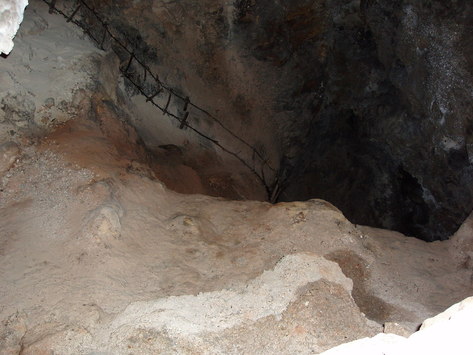A subterranean corridor opens up to reveal this huge underground space, eight acres (3 hectares) in area, irregular in height and layout. Massive, fluted stalagmites and knobby columns rise up more than a hundred feet (30m) toward an inverted forest of thin stalactites decorating the ceiling. The room floor rises and falls in a seemingly random manner, so that an explorer must spend as much time negotiating ascents and descents as walking on level ground, and must take care to skirt deep pits.
Dimensions The room is 900 feet (300 m) long and 400 feet (120 m) across, with a ceiling that vaults 250 feet (75 m) above the floor in some places. Several of the largest stalagmites exceed 15 feet (4 m) diameter.
Key Details
- In addition to its large-scale mounds, valleys, and columns, the chamber’s floor has clusters of smaller stalactites that remain large enough to hamper movement.
- The near-silence here (with only quiet sounds of dripping water) allows sound to travel long distances, while darkness and a multitude of obstacles severely limit field of view.
- The perimeter of the room includes many small and large alcoves, marked off by protruding half-walls of bedrock. These alcoves, as well as passageways leaving the chamber, have very irregular ceiling profiles with dissolved-out domes and other bulbous cavities.
- Pits on the chamber floor may narrow with depth, or lead to larger-sized open chambers below.
- Some passages exiting this vaulted space are high on the room walls, sometimes above protruding ledges and difficult to see from below.
- Multitudes of bats occupy other parts of this cave system, passing sporadically through this chamber.
- Mineral resources available here in the cave include gypsum, used to make cements, plaster, and mortar; and deep deposits of bat guano, raw material for gunpowder manufacture. Both materials are also used as agricultural fertilizers.
- The room’s travertine deposits display many textures, rough cauliflower- or popcorn-like surfaces contrasting with tapered draperies and smooth, rounded flowstone surfaces. The rough deposits, originally formed beneath standing water, abound on the walls in the lower half of the room, as well as on the lower tips of some stalactites.
Story Elements
- Entering this cave, especially this immense room, is like entering another world, with both delicate and massive features.
- The irregular form of the room walls, ceiling, and floor, as well as limited range of vision, make it very easy to lose sense of direction. The travertine surfaces will only rarely retain footprints.
- What would it be like exploring this room in zero gravity?
- Despite the silence, navigating by sound is of limited use in this large, echo-prone room. The source of a distant hail or call for help will be difficult to pinpoint. A character in a vulnerable situation, hearing footsteps or voices, will not be able to tell if they are near or far away.
- The many semi-private alcoves in the room walls could make this a good site for a short- or long-term settlement.
- The high/hidden passages would be excellent story turning point locations. Reaching these challenging passages might be a way characters ‘earn’ treasure, insights or other story milestones.
- Characters climbing a hanging rope through this huge open space, with vertically rising columns in the background, could make quite a picture.
- A story could center around conflicts over the cave’s resources.
- Bats won’t intentionally fly into people’s hair, but their presence might cause characters to freeze in place to avoid being hit accidentally. (Cave veterans will make some low, continuous noise to alert the bats to their presence.)
- Stalagmites here can’t be easily toppled or broken.
- This is one of the most visited caves in the United States, with easy access via an elevator (most caves have fairly challenging entryways). People with claustrophobia are more likely to visit here than most other close spaces.
- The huge room, exotic beauty, narrow walkways and (often) large crowds could lead to dramatic interactions. Crime! Love! Loss! International intrigue? You decide.
- Combat dynamics:
- Stalagmites will complicate hand-to-hand combat and provide hiding places for snipers.
- When characters get slammed into walls, they might be scraped by rough-contoured deposits, or disappear into unnoticed cavities.
- The high passages and many alcoves on margins of this space provide many strategic possibilities, for those who know their layout.
Reference Location
The Big Room, Carlsbad Cavern, Carlsbad Caverns National Park, southeastern New Mexico. It is part of the Guadalupe Mountains region, which also hosts the Boulder Canyon, Desert Streambed Throughway, and Oasis scenes.
© Rice-Snows 2017
Proudly powered by Weebly





